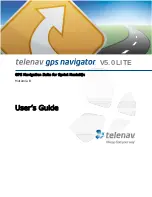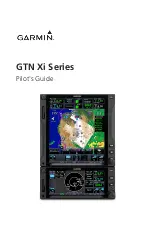
148
E-Series Networked Display Reference Manual
from the coastline. Although the coastline may be much nearer, it may not appear
on the radar until the vessel is closer to shore.
• Some targets, such as buoys and small boats, can be difficult to discern, because
they do not present a consistent reflecting surface as they bob and toss about in the
waves. Consequently, these echoes tend to fade and brighten and at times, to dis-
appear momentarily.
• Buoys and small boats often resemble each other, but boats can often be distin-
guished by their motion.
7.5 Marking a position on the radar screen
You can mark a position by using a waypoint. Waypoints are positions marked on the
screen as a reference or destination point and are stored in the Waypoint list. They can
also be used to build routes and assist in passage planning.
Waypoints are placed on the radar screen via the
WPTS/MOB
button in the same way
as they are placed on a chart.
You can edit waypoints and navigate to waypoints in the radar window
For full details on using waypoints and passage planning see
Chapter 3:Working with
Waypoints
and
Chapter 4:Using the Chart
.
7.6 Changing what you see in the radar window
The radar screen can be tailored to your particular needs. You can:
• Change how the radar is orientated (see
page 148
).
• Change where your boat is positioned (motion mode) in relation to the radar (see
page 150
).
• Show or hide waypoints (see
page 46
).
• Show or hide range rings (see
page 152
).
• Change the bearing mode for EBLs (see
page 152
).
• Show AIS targets.
Note:
The radar settings are locally applied and will therefore only affect the individu-
al display on which you are working.
Setting the orientation of the radar
The orientation of the radar refers to the relationship between the radar and the
direction that you are travelling in. There are three orientation modes to choose from:
• Head up.
• North up.
• Course up.
Summary of Contents for E120W
Page 1: ...E Series Networked Display Reference Manual Document number 81244_2 Date March 2006...
Page 22: ...6 E Series Networked Display Reference Manual...
Page 48: ...32 E Series Networked Display Reference Manual...
Page 194: ...178 E Series Networked Display Reference Manual...
Page 200: ...184 E Series Networked Display Reference Manual...
Page 206: ...190 E Series Networked Display Reference Manual...
Page 226: ...210 E Series Networked Display Reference Manual...
Page 254: ...238 E Series Networked Display Reference Manual...
Page 272: ...256 E Series Networked Display Reference Manual...
Page 276: ...260 E Series Networked Display Reference Manual...
















































